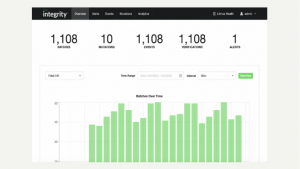
“Most people still view blockchain in terms of crypto currencies and not as a data technology for practical enterprise solutions,” says Phil Ressler, CEO of Sixgill. “With Integrity 2.0, Sixgill provides any organization with a real-world, real-time, blockchain data authenticity guarantor that achieves absolute data veracity, now also with a SaaS version for easy entry.

“Our hybrid-hybrid authenticity architecture allows any enterprise to start building data integrity into IoT and IoE automation processes using a well-understood private blockchain, with the option to add public blockchain immutability when the most stringent protections are mandated. This also enables easy generation of immutable audit trails for highly regulated processes or where liability for errors runs high.”
Sixgill and Integrity 2.0
The objective of Integrity 2.0 is to make blockchain data integrity practical for enterprises so that the latter can address the rising need for end-to-end, real-time data authenticity assurance. Enterprises are able to monitor and guarantee the veracity of any data stream (or data in motion). This includes sensors emitting time-series data in any form – including video data.
Integrity 2.0 offers a system of checks and balances. These seek to ensure data integrity – both within an organisation or across a trusted consortium/collection of organisations. Such organisations gain the assurance that the data they create, transmit, process, act on and store, remains unchanged and tamperproof throughout its lifecycle. What Sixgill adds with Integrity 2.0 is a SaaS version that makes it easier to start.
Integrity 2.0, as a SaaS offering, should offer the following benefits:
- end-to-end data lifecycle immutability
- permanent and continuous regulatory-grade data auditability
- a rules engine which can define and trigger actions
- a functionality that is data-, device- and ledger- agnostic
- real-time autogeneration of analytics
- automated real-time alerts of any data compromise
- visibility into who has permissions, what activities they are performing and who has accessed data or added data, etc.
- deployment to single-tenant private clouds or custom on-premise deployment
- the ability to handle any data type, including video data
- multiple channels for different data types and data streams
- multiple credentials (for different users with different levels of access/permissions)
- robust APIs as well as developer tools and documentation.
Integrity 2.0 and Hyperledger Fabric
Sixgill has built Integrity 2.0 on IBM Hyperledger Fabric, a private blockchain, yet uses the public Bitcoin blockchain as an optional trustless, immutable auditor. This approach is customisable so that customers can choose their blockchain.
Integrity 2.0 achieves this by maintaining the on-chain/off-chain scheme originally delivered in Integrity 1.0. It assures the performance required to ‘sheath’ data in motion and generate any necessary corruption alerts in the unlikely event there is any compromise an Integrity-protected data stream.
In effect, Integrity 2.0 ensures that organisations – including stakeholders, regulators, clients and others – can trust their data, particularly high-stakes data automation applications. Use cases span multiple industries which include:
- Supply chain: immutable data evidence of authenticity of goods origin, permanent traceability to originating data sources and the secure exchange of transaction information, history and compliance details.
- Pharmaceuticals/healthcare: permanent auditability, traceability and certainty required for regulatory-grade medical and clinical trial data records (Intel recently profiled a current healthcare instance with use of Integrity 2.0).
- FinTech: unalterable transaction records for permanent audit trails.
- Utilities: backbone data integrity for widely distributed infrastructures enables centrally managed, system-wide programmatic actions triggered by device, data and contextual rules for operating on data truth.
- Insurance: verified data lifecycle authenticity for rate setting and claim settling – from smart devices to smart homes, sensor-intensive vehicles, smart buildings, etc.
- Video surveillance: permanent data immutability and auditability for tamperproof video data streams with configurable alerting to any tampering.
Enterprise Times: what does this mean
SaaS approaches are attractive because they are readily accessible and then scalable. Integrity 2.0 fall into this cateogory. As a SaaS offering it should offer self-service as well as managed instances with multi-tenant support.
Sixgill claims Integrity 2.0 stands apart from other data security offerings. It justifies this via its use of maximum-integrity properties of DLT with a modern distributed data system. It achieves this via what Sixgill says is its unique on-chain/off-chain hybrid-hybrid architecture which marries:
- the immutability of private and public blockchains
- an off-chain data layer that preserves real-time performance at scale.
What is also intriguing, to Enterprise Times is the ability of Sixgill to leverage the Bitcoin blockchain. This Bitcoin layer sits on top of the Integrity Hyperledger enterprise solution. Sixgill’s assertion is that this achieves levels as close as possible to 100% immutability. This, of course, is only valid if one accepts that Bitcoin is unbreakable.

























